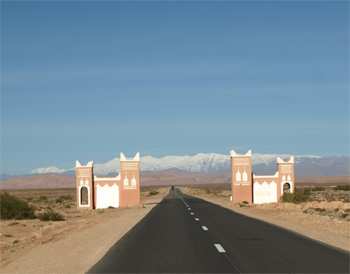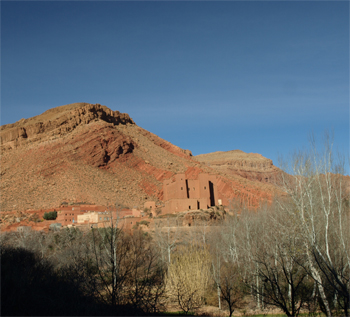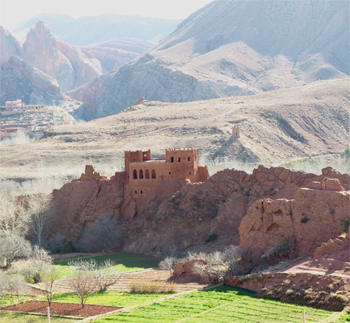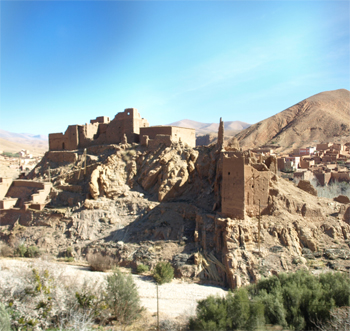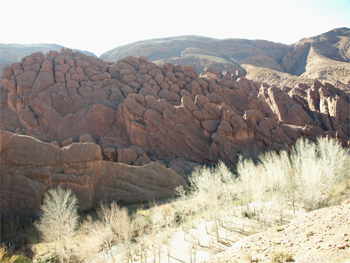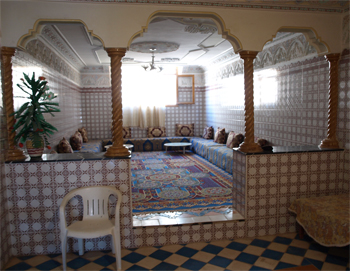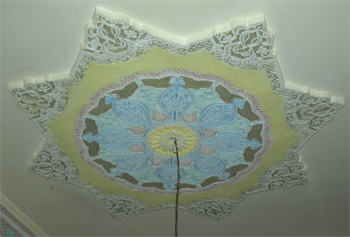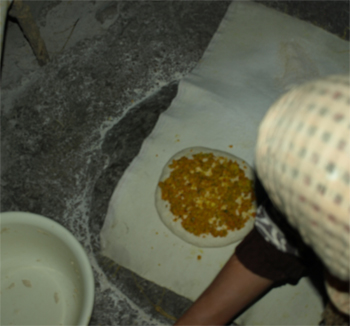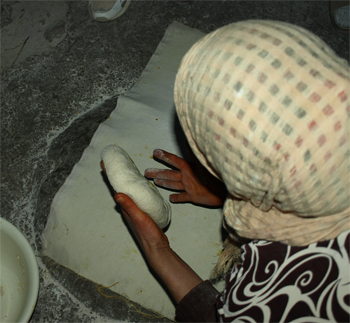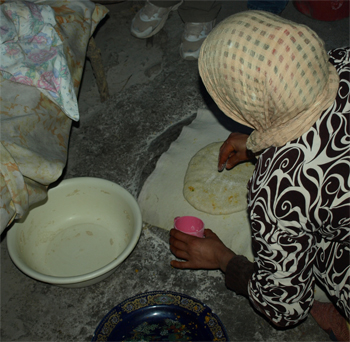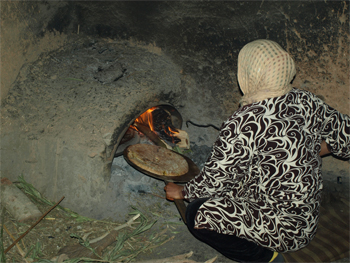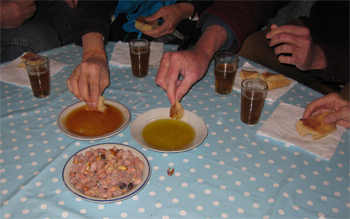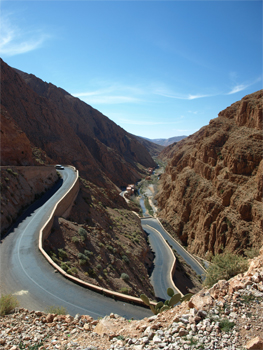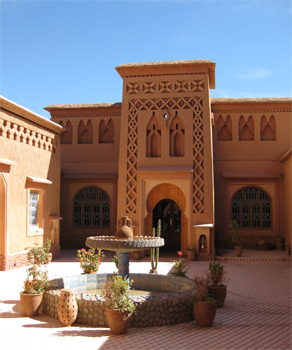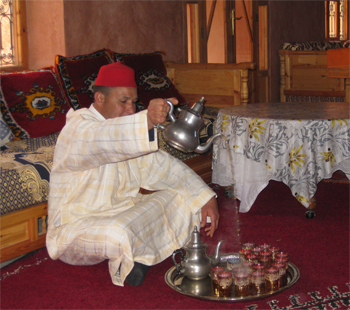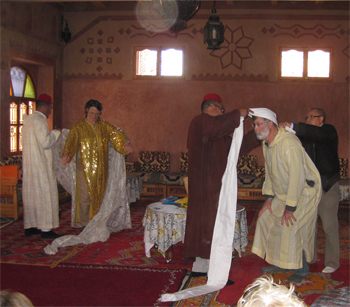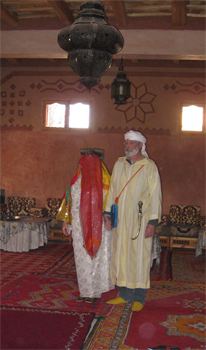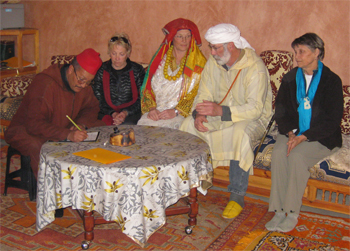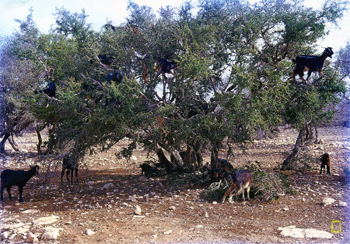2/13/11 - Tineghir to Ouarzazate
As we left Tineghir we drove along and then into the Anti-Atlas Mountains. We stopped for pictures of a typical gate across the road that separates one province from another. This one separated Tineghir from Dades. The snow covered High Atlas Mountains were in the distance.
We had a panoramic view looking down on the town of Dades with the Wadi (river) Dades running through it providing fertile ground. There are no date palms here but many fig and poplar trees. The poplars are used for ceiling beams, etc. On the hillside opposite was an Arabic message written with white rocks: “The Western Sahara is Ours.” We later saw several more of these political statements.
Gate between Tineghir and Dades |
Dades with “The Western Sahara is Ours” on the hillside
|
We turned off the road to Ouarzazate and headed up to the Gorges de Dades. This road is known as the Road of 1000 Kasbahs. These are castles with four corner towers and owned in the 19th c. by the very wealthy and powerful landlords during the feudal system of land holding and serf farmers. Many of the old kasbahs are being restored with financial help from UNESCO and the Moroccan government. We stopped to gawk at a strange geological formation of hoodoos called the "brain of the Atlas. These mounds were uplifted from the bottom of the sea.
|
|
Old kasbah |
Kasbah
|
Kasbahs and mosque |
Kasbah on rocky outcrop (unusual)
|
Kasbah
|
"Brain of the Atlas" rock formation |
We stopped at the base of the Dades Gorge to visit a family and the woman who makes a special Moroccan bread called msemmen. We squeezed into her baking room with its adobe wood burning oven and slightly domed kneading surface on the dirt floor. She made a flour and water sourdough, patted it round and flat, spread it with a "sauce" of cilantro, garlic, saffron, onion, carrot, salt, and some fat (olive oil), turned the edges to the center, packed it down flat again and let it rest for a little while before baking it on a ceramic surface in the oven. (These adobe bread ovens are interesting because the wood fire is pushed to one side and the bread is baked on the opposite side. The ovens are only about two feet in diameter.) She used coarser ground flour instead of cornmeal to keep it from sticking. We went to the dining/family room, took off our shoes, and ate bread with homemade honey or olive oil and then the msemmen and were served tea. Several members of the extended family sat and watched us eat. The children were adorable.
We stopped for lunch in Kalat Migouna at a beautiful kasbah restored by a local Imam who is also a notary and who can write marriage contracts. We ate lunch at low tables and ate lentil soup, a tagine of chicken, carrots, zucchini, Hubbard squash, turnips, and semolina with tangerines and bananas for dessert and mint tea served ceremonially. The tea is poured from the silver pot held way high above the little tea glasses. It must take practice to aim the liquid into the little juice glasses. The meal was very good, again. The table was cleared by folding up the plastic tablecloth with the orange and banana peels inside. Mohamed told us that at a feast, the number of table cloths indicates the number of courses. People would sit down and count the cloths!
After lunch we learned about the civil process of marriage, which is held in the home in Morocco. Martha and Dan volunteered to demonstrate the rituals. Our host, his brother, and the cook dressed them in traditional bride and groom clothes. Our host wrote the contract asking Dan what was his dowry and asking Martha if she freely wanted to marry him and accept his dowry. Sara and Linda were witnesses and all signed the contract. It was an interesting demonstration and they were all good sports.
Another Moroccan tea ceremony
|
The wedding ceremony - getting into the traditional dress |
Ready for the ceremony
|
Writing the marriage contract - Imam, bride and groom, and witnesses |
Our afternoon stop was in the "rose valley." Roses grown here are used to make rose water, soap, and skin creams. I really like the Moroccan tradition of cleaning your hands with sprinkled rose water before meals. We bought Argan Cream at the shop to use on Marge's cheek scar and a post card showing the goats in the argan trees eating the fruit. The goat poop is then collected by local women, cleansed, dyed, and made into a powder. The powder is sold to cosmetic factories. Argan creams are very rich in vitamin E, which helps soften scars. So Marge is now putting "goat poop" on her face.
http://en.wikipedia.org/wiki/Argan
http://en.wikipedia.org/wiki/Argan_oil
Goats in the trees eating argan fruit
|
